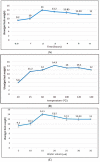Prospective Antiviral Effect of Ulva lactuca Aqueous Extract against COVID-19 Infection
- PMID: 38248655
- PMCID: PMC10817659
- DOI: 10.3390/md22010030
Prospective Antiviral Effect of Ulva lactuca Aqueous Extract against COVID-19 Infection
Abstract
Marine algal extracts exhibit a potent inhibitory effect against several enveloped and non-enveloped viruses. The infection of severe acute respiratory syndrome coronavirus 2 (SARS-CoV-2) has several adverse effects, including an increased mortality rate. The anti-COVID-19 agents are still limited; this issue requires exploring novel, effective anti-SARS-CoV-2 therapeutic approaches. This study investigated the antiviral activity of an aqueous extract of Ulva lactuca, which was collected from the Gulf of Suez, Egypt. The aqueous extract of Ulva lactuca was characterized by high-performance liquid chromatography (HPLC), Fourier-transform infrared spectroscopy (FTIR), X-ray diffraction (XRD), and Energy Dispersive X-ray (EDX) analyses. According to the HPLC analysis, the extract comprises several sugars, mostly rhamnose (32.88%). The FTIR spectra showed numerous bands related to the functional groups. EDX analysis confirmed the presence of different elements, such as oxygen (O), carbon (C), sulfur (S), magnesium (Mg), potassium (K), calcium (Ca), and sodium (Na), with different concentrations. The aqueous extract of U. lactuca (0.0312 mg/mL) exhibited potent anti-SARS-CoV-2 activity via virucidal activity, inhibition of viral replication, and interference with viral adsorption (% inhibitions of 64%, 33.3%, and 31.1%, respectively). Consequently, ulvan could be a promising compound for preclinical study in the drug development process to combat SARS-CoV-2.
Keywords: Egypt; Ulva lactuca; anti-SARS-CoV-2; antiviral; ulvan.
Conflict of interest statement
The authors declare that the research was conducted in the absence of any commercial or financial relationships that could be construed as a potential conflicts of interest.
Figures







Similar articles
-
Considerable Production of Ulvan from Ulva lactuca with Special Emphasis on Its Antimicrobial and Anti-fouling Properties.Appl Biochem Biotechnol. 2022 Jul;194(7):3097-3118. doi: 10.1007/s12010-022-03867-y. Epub 2022 Mar 26. Appl Biochem Biotechnol. 2022. PMID: 35347670 Free PMC article.
-
Chemical Composition of the Red Sea Green Algae Ulva lactuca: Isolation and In Silico Studies of New Anti-COVID-19 Ceramides.Metabolites. 2021 Nov 29;11(12):816. doi: 10.3390/metabo11120816. Metabolites. 2021. PMID: 34940574 Free PMC article.
-
Fighting SARS-CoV-2 with green seaweed Ulva sp. extract: extraction protocol predetermines crude ulvan extract anti-SARS-CoV-2 inhibition properties in in vitro Vero-E6 cells assay.PeerJ. 2021 Nov 15;9:e12398. doi: 10.7717/peerj.12398. eCollection 2021. PeerJ. 2021. PMID: 34820178 Free PMC article.
-
The Potential of Algal Biotechnology to Produce Antiviral Compounds and Biopharmaceuticals.Molecules. 2020 Sep 4;25(18):4049. doi: 10.3390/molecules25184049. Molecules. 2020. PMID: 32899754 Free PMC article. Review.
-
The Antiviral, Anti-Inflammatory Effects of Natural Medicinal Herbs and Mushrooms and SARS-CoV-2 Infection.Nutrients. 2020 Aug 25;12(9):2573. doi: 10.3390/nu12092573. Nutrients. 2020. PMID: 32854262 Free PMC article. Review.
Cited by
-
Extraction of degraded proteins from red and green macroalgae using ultrasonic-assisted extraction and Fenton's reagent in combination.Curr Res Food Sci. 2025 May 27;10:101085. doi: 10.1016/j.crfs.2025.101085. eCollection 2025. Curr Res Food Sci. 2025. PMID: 40529649 Free PMC article.
-
Cell protective effects of vitamin C against oxidative stress induced by ciprofloxacin on spermatogenesis: involvement of cellular apoptosis.Front Cell Dev Biol. 2025 Mar 20;13:1489959. doi: 10.3389/fcell.2025.1489959. eCollection 2025. Front Cell Dev Biol. 2025. PMID: 40196846 Free PMC article.
References
-
- Domínguez H. Functional Ingredients from Algae for Foods and Nutraceuticals. Elsevier Science; Amsterdam, The Netherlands: 2013. Algae as a Source of Biologically Active Ingredients for the Formulation of Functional Foods and Nutraceuticals; pp. 1–19. - DOI
-
- Moreira A., Cruz S., Marques R., Cartaxana P. The Underexplored Potential of Green Macroalgae in Aquaculture. Rev. Aquacult. 2022;14:5–26. doi: 10.1111/raq.12580. - DOI
-
- Gheda S., El-Sheekh M.M., Abou-Zeid A. In Vitro Anticancer Activity of Polysaccharide Extracted from the Red Alga Jania rubens Against Breast and Colon Cancer Cell Lines. Asian Pac. J. Trop. Med. 2018;11:583–589. doi: 10.4103/1995-7645.244523. - DOI
MeSH terms
Substances
Supplementary concepts
Grants and funding
LinkOut - more resources
Full Text Sources
Medical
Miscellaneous

